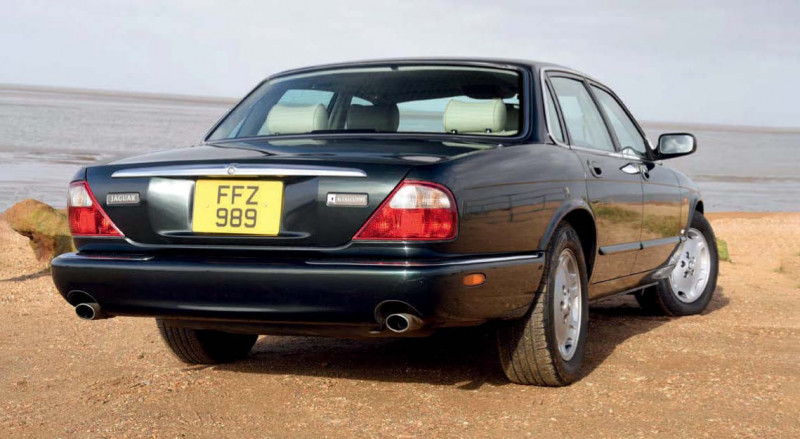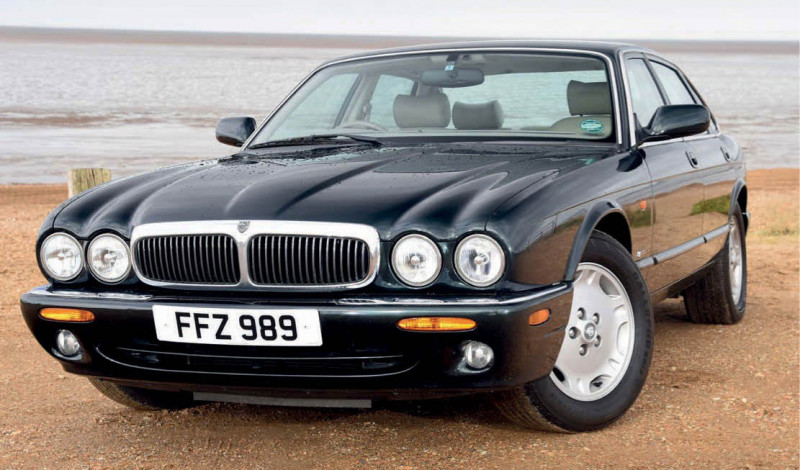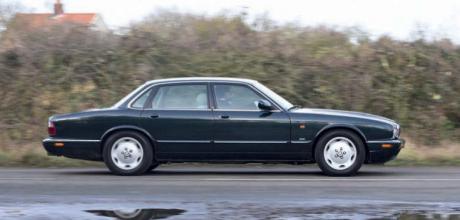1998 Jaguar XJ8 Executive X308
The first V8 Jaguar saloon has enjoyed a mixed reputation. But what’s it like today?Words: Sam Skelton. Photography: Paul Walton.
FIGURE OF EIGHT
The last of the traditional XJ saloons… and the first to pack a V8 punch.
The Jaguar X300 wasn’t supposed to happen. After the aggressively styled XJ40, Jaguar’s intention had been to launch an all new saloon, with an all new V8 engine. Ford’s money men halted development of the saloon, termed XJ90, and proposed installing its new engine and front and rear ends onto the centre section of the XJ40 model. Great idea – except that the V8 wasn’t ready.

This would have been a problem for Jaguar. Both Mercedes and BMW had launched new models during the XJ40 reign and without a successor to its own solitary saloon Jaguar’s financial position would have become perilous. The stopgap measure was to revise the existing six cylinder engine, apply the facelift to the shell, and release it onto the market until the V8 was ready. The X300 became one of Jaguar’s most successful production models relative to its time in the showrooms, but everyone at Browns Lane knew that the real story would follow just a few short years later.

That car, launched in August 1997, was the X308. On the outside, tiny V8 badges on the B-pillar let everybody know the score. For the more observant, there were new bumpers with oval shaped indicators and side reflectors in place of the rectangular units of the X300, new foglamps, a small crease to the bottom of the rear bumper, and new quarter blades to the bumpers which would end the chromium crease found in the centre after an owner had misjudged a parking space. Inside, everything was new, with dials recessed in XK8 style pods, new switchgear, and greater concession to ergonomic bliss. But the big news was under the bonnet. Each of the six cylinder variants – the 3.2, 4.0 and supercharged 4.0 XJR – was replicated in V8 form, now attached to five speed automatic gearboxes as standard and the start of a brief period whereby Jaguar would not offer a manual gearbox.
The V12 was gone, and with it the XJ12 – the Daimler Double Six was replaced with a long wheelbase XJR-derived luxury liner called the Super V8. Initial press was positive; with Autocar, Car and others praising the new engine’s refinement, power and relative economy. But soon, stories of a different nature entered the press. Nikasil coatings to the cylinder bores would wear away, and engine blocks would begin to erode.
As if this wasn’t bad enough, timing chain tensioners and thermostat housings made of plastic would shatter. The new engine wasn’t shaping up to be as bulletproof as the older six. But with metal tensioners and thermostat housings available and revised bore liners from 1999, the majority of surviving examples can be made into classics just as reliable and long-lived as the outgoing model. Priced to compete with the BMW 5 and 7-Series, and the Mercedes-Benz E-class, Jaguar brought a sense of style to the party as well as the power and comfort the brand had become known for. The range evolved gently, though with no major changes until its replacement was launched in 2002.
This car, the all aluminium X350, would be a very different type of XJ under the skin. Today, many dismiss the XJ8 as the X300’s cheaper cousin, a facelift too far and a sign that Jaguars should come with six cylinders rather than eight. But here at Classic Car Mart, we think they’re missing out. In order to delve deeper, I borrowed this Japanese specification XJ8 4.0 from Kim Cairns Classic Cars, in Norfolk. Finished in Sherwood Green with Oatmeal trim, it’s almost the archetypal example. It may differ in the details from UK equivalents, but the overall driving experience shouldn’t be too dissimilar. Eagle eyed Jaguar spotters will note the XJ8 4.0 badges on the front wings, the alloy wheels nabbed from the UK-spec X300 Executive, and the bootlid complete with square registration plate holder as marks that this car deviates from UK spec. Early UK 4.0s came with the chrome trimmings of this car, but with 17” Celtic alloy wheels. Later models were trimmed in a manner closer to the youthful 3.2 Sport, or optionally with the full chrome and interior ambience of the prestigious Sovereign. From outside, it looks little different to the X300 Sovereign I arrived in – I’ve owned six-cylinder XJs for many years, and the cosmetic similarity is something I find pleasing. At the time it appeared slightly dated, too similar to the outgoing model, and yet today it’s a shape which has aged well. Inside, it’s far more logically laid out, even if the single piece mouldings for the dash and door cards on this model are in single, contrasting tones. The steering wheel and driving position feel cosily familiar, though the overall aesthetic is wildly different. The keys are identical too, to the point where I attempted to start this car with the key to my own Sovereign while moving it for the photographs. Only the changed remote fob gives the game away. The starter motors sound identical, but as the engine settles the slightly off beat V8 thrum is very different to the sporting six in my own car. It’s somehow smoother despite its configuration, and there’s less of a mechanical feel as you slip the car into D on the J gate. Under the bonnet of this example sits the same 4.0 V8 you find in the XK8, with 290bhp and 290lb.ft of torque.
Those figures are rather nearer to the six cylinder XJR than to the old 4.0 in naturally aspirated form, and as a result it’s disarmingly easy to chirp the tyres as you pull away. Once you remember just how much power is under your right foot it’s controllable, though, and one of the most serene cars on the road. And on the road is where the XJ8 excels most of all. Its static qualities may be myriad, but once you’re moving it’s hard to believe you’re in a vehicle of its size and clout. Somehow, the ride manages to shame even the model it replaces, with less propensity to premature bush wear and the attendant clonking this induces from the rear end. It laps up the bumps beautifully, and it’s only when you get back into something else that you appreciate just how good the ride really is. There’s better body control, too, and the car feels less weighty and more poised than the older XJ6 models. Not surprising, with an average drop of around 200kg model for model, almost all of which was lost under the bonnet courtesy of that light and compact engine.
That weight loss combined with the extra gear mean that the V8 is far more economical than the older car, too – we suspect that 30mpg might be a very real average possibility from this 4.0 V8, where a 4.0 six would average no more than 27. But where it really comes into its own is when you chuck it into a corner. The older six was never exactly an unwieldy machine, but you were always aware you were driving almost seventeen feet of car. The V8 models, on the other hand, barely feel bigger than a 5-series BMW, offering far greater driver confidence. The 370bhp on tap from the supercharged XJR must make for a mind blowing machine if a standard 4.0 feels quite this good. You don’t need to play with the manual control on the left hand side of the J gate, but when you do the XJ almost moves like a sports car. It feels unfair to compare this car to the one which came before – to judge it solely in the context of its predecessor, rather than as its own entity. And yet because of their similarity you can’t help but feel yourself mulling over their similarities and differences. The X300 is arguably more handsome in its details and certainly more traditional, but the X308 is sharper and smoother to drive, with the ergonomic rough edges gently honed away. It feels like an evolution rather than a revolution, and somehow that’s how Jaguars always feel best to us.
There’s greater divergence from the model which followed – the X350 might have been more economical still, lighter still, but it somehow feels corporate in a world where the X308 feels like a more personal choice. There’s nothing you can put your finger on, but the X350 feels less special than this. Maybe it’s because the X308 is such a compromised car that you can’t help but appreciate it? There’s scant space in the back if you’re tall, and if you take more than a toothbrush weekend luggage for two might not fit in the woefully inadequate boot space. Jaguar attended to these faults and more for the X350, and it feels like it’s lost some of its sense of personality as a result. An X308 XJ8 might have been a mass produced model, but viewed against its German contemporaries such as the S class and the 7-Series it feels as up to date and as relevant as a Bristol, it’s separate transport for a separate kind of person. And that’s what makes it such a compelling classic today. In the BMW you feel like regional manager of the year. In the Jag, you feel like you own the company.
But you don’t have to own the company to be able to afford the Jag. Today, you can get a reasonable X308 for £2500, and a very nice one for £5000 – double those figures if a supercharged XJR would be more your thing. The breadth of the range when new means there’s something for all tastes, from the youthful 3.2 Sport to the golf club captain spec Sovereign, and the lord of the manor Daimler with its fluted chromework and its separate rear armchairs. And while this doesn’t seem like a lot of money, consider this. In 2019 I bought two X308s, each for under £500. Both had issues, but even those cars would be knocking on the door of a thousand pounds today. The market is slowly coming round to the awareness of just how good these cars car be, and buying at today’s prices will seem like a very canny decision in tomorrow’s world. If you’re considering one, check for rust on all lower extremities and on the rear subframe, look through the history to check it’s had the thermostat housing and timing chain tensioner replaced and if an early car see if it’s had any work regarding the Nikasil bore liners. And make sure the toys work – these and the bodywork are the most expensive fixes. It might be the model people shy away from, but the Jaguar X308 XJ is a performance and luxury bargain today – and a sure fire classic investment. Now is certainly the time to buy, and we heartily recommend that you should.
The modern V8 engine shaved 200kg from the front end, with all the expected handling benefits. The AJ-V8 engine would usher in a new era for Jaguar as a brand.
Square plate and detail trim differences reveal this example as an ex-Japan car.
Despite its size the XJ8 feels light on its feet when hustled, in the best XJ tradition.
“Jaguar brought a sense of style to the party as well as the power and comfort the brand had become known for”
SPECIFICATIONS JAGUAR XJ8
- ENGINE 3996cc V8
- MAX POWER 294bhp at 6100rpm
- MAX TORQUE 290lb.ft at 4250rpm
- 0-60 MPH (SECS) 6.9secs
- MAX SPEED 150mph
- ECONOMY 30mpg
- LENGTH 5.0m
- WIDTH 1.8m
- KERB WEIGHT 1790kg



I’m a subscriber to your magazine following purchasing a copy off the shelf at WH Smith. Have to say, I really like it. Good layout and drops the pretentious typical Jaguar magazine whereby anything not an XJ or made pre-Ford ownership is ‘not a Jaguar’. Your piece comparing the X300 and X308 XJRs was a pleasure to read, informative and is what convinced us to become subscribers to your magazine especially as we own both an X300 and an X308.
So I was excited when our (terminally grumpy) postman dropped the April 2022 issue through the door, highlighting eight affordable classics to use every day, and what should be mentioned? The very lovely X308, with a side dish of Jaguar S-TYPE (owned one and was hideously unreliable but absolutely loved it), lightly garnished with X-TYPE too. This is going to be a cracker I thought. But with an X308 literally dripping in mud from another week’s work travels, and an X300 that is dead in the water thanks to a bad security module. Reading will have to wait until Sunday morning coffee. C’est la vie.
So this morning I delved in to see what’s been written and what comes out on top. And thoroughly loved the writeups. A very honest depiction on all eight but with one glaring mistake, a mistake that appears on the X308 write up and was then carried over to the S-TYPE write up. And that is one of road tax. You say that the Road Fund License is a ‘crippling £600’ for the 2002 made cars on the X308 because of the CO2 rules brought in in 2001. Yes, these rules were brought in and the later 2001-2002 cars are subject to this however (here’s where it gets interesting), cars with a CO2 figureover 225g/km and made before 23rd ofMarch 2006 actually slip into band K whereby they are only subjected to a “minor hobbling” of £360 per year cost, not the full ‘cut off at the knees’ £600. This too applies to the S-TYPE where it’s only the later cars post 2006 that get the full wallop of the £600. Pre-2001 cars are cheaper again being £280 per year, costing the same as an XJ6 Series 3 or XJ-S. Please, please, please can we be aware of glaring mistakes like these especially in articles where we are trying to convince people that these are an everyday option. Also I think they should both gain a star for economy… Go on, you owe it to them. My X308 XJ8 is an everyday miler.
Taking me from Plymouth to my work (Kingsbridge, Dartmouth and Newton Abbott) every day, racking up 40,50 even 60 miles a day. Now I may hear some of your readership gasp in horror (at either the audacity to treat an XJ as a workhorse or the fact I am single-handedly killing the planet while funding yet another party at Number 10 just on fuel duty), but it has proved as therapy to me for both the drive to and drive back from a busy day. As someone who has suffered severe bouts of depression, I am definitely of the mindset that sometimes you have to live a little every day to truly live a life. Pulled from a barn in a last minute bid to help a bride get to her wedding after being let down by someone else and our own X300 letting us down (on Father’s Day of all days), it was a dubious start to a relationship but one that’s blossomed into Darcy becoming a full blown member of the Brickell/Walsh household. I’ve also included some pics of her at a car meet recently, because, well, why not.
Anyway, keep up the (mostly) spot onjob of writing for this wonderful marque.